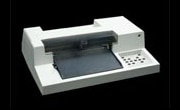 |
 |
 |
 |
The grit wheel plotter used sandpaper as a practical solution to an engineering problem. |
The grit wheel plotter was invented by an HP engineer named Larry
Labarre, who worked in HP Labs from 1952 to 1983. He was a mechanical
engineer, and his reputation for creativity, inventiveness, sound
implementation and independent thinking was legend. One day, while
struggling to build a personal computer plotter, Bill Hewlett said
to Larry "What we need, Larry, is something that can move this
paper back and forth without slipping."
In a previous job, Larry had had some experience with knurled
power feed rollers used to drive lumber into a saw. In about two
days he came up with the simple, elegant solution of bonding a ring
of 80 to 120 Carborundum paper around the paper drive roller. The
sandpaper would grab the paper and move it. A patent was applied
for on October 24, 1980.
In 1986 Bausch & Lomb sued HP claiming that Larry's invention
was not still the "best way" and the patent should not
be allowed to persist. By then HP's San Diego division (Currently
HP's Imaging and Printing Systems business) was dipping the
wheel in epoxy and then applying grit to cover the glue. But on
the stand, Larry steadfastly claimed that his method was still the
best way and the least expensive means to the end. HP prevailed,
and Larry's patent was sustained.
|

